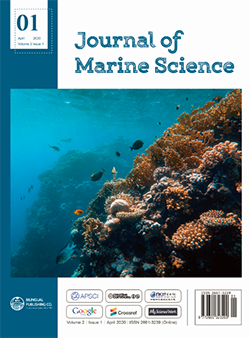Can Air Quality be Influenced in Coastal Areas by Shipping?
DOI:
https://doi.org/10.30564/jms.v2i1.1287Abstract
The problem of pollution is a topical issue at global, regional but also at the local level. Starting from this idea, the question arises whether the coastal region in the North-East of the Black Sea is affected by the emissions resulting from the combustion of marine fuels in large ship engines, which manage to set in motion floating buildings intended for the transport of goods and passengers. This paper wants to evaluate the variation of the air quality indicators in the coastal area of Romania, taking into account the contribution that the ships by their number, size and destination can have on these qualitative factors. Such an approach is needed from the perspective of the more than 500,000 inhabitants possibly affected by the effects with which this industry is accompanied. As the Black Sea active fleet is already old, as its ages year by year, the premises for the need for this study can be set up. As in other regions, drastic measures are taken in order to reduce the effects of pollution due to such economic activity, the assessment of the effects that this industry produces in inhabited areas becomes necessary. In order to carry out this study, air quality data from the database provided by the National Air Quality Monitoring Network of the Workshop on the calitateaer.ro site were evaluated.
Keywords:
Air quality, Black Sea, Particle matter, Shipping emissions, SustainabilityReferences
[1] EU climate action (Accessed August 2019): https://ec.europa.eu/clima/citizens/eu_en
[2] EMSA (Accessed September 2019): http://emsa.europa.eu/main/air-pollution/greenhouse-gases.html
[3] IMO, Third IMO. Greenhouse Gas Study, Executive Summary and Final Report, London, 2014 (Accessed September 2019):
[4] http://www.imo.org/en/OurWork/Environment/PollutionPrevention/AirPollution/Pages/Default.aspx
[5] L. Rusu, A. Raileanu, F. Onea. A Comparative Analysis of the Wind and Wave Climate in the Black Sea Along the Shipping Routes, MDPI Water, 2018, 10: 924.
[6] DOI: 10.3390/w10070924
[7] Maritime transport statistics - short sea shipping of goods. (Accesed in September 2019): https://ec.europa.eu/eurostat/statistics explained/index.php/Maritime_transport_statistics__short_sea_ shipping_of_goods
[8] V. Eyring, H. W. Kohler, J. van Aardenne and A. Lauer. Emissions from international shipping: 1. The last 50 years, Journal of Geophysical Research, 2005, 110: D17305.
[9] DOI: 10.1029/2004JD005619
[10] V. Rata, L. Rusu. ASSESSING THE TRAFFIC RISK ALONG THE MAIN BLACK SEA MARITIME ROUTES, Proceeedings of ICCTE Belgrade 2018.
[11] ISBN: 978-86-916153-4-5
[12] Marinetraffic.com (Accesed in September 2019):
[14] Google Earth application.
[15] Air Quality, Air Quality Monitoring National Network, (Accesed in September 2019): http://calitateaer.ro
[16] V. Rata, C. Gasparotti, and L. Rusu. The Importance of the Reduction of Air Pollution In The Black Sea Basin, Mechanical Testing and Diagnosis, 2017 (VII), 2: 5-15.
[17] ISSN: 2247 – 9635
[18] V. Rata, L. Rusu. Air pollutant products resulting from port activity of ships in Constanta harbour, Proceeding of SGEM Albena 2019 Conference, 2019.
[19] DOI: 10.5593/sgem2019/4.1/S19.104
[20] V. Rata, A. Hobjila, and L. Rusu. LNG to Power in the Romanian port of Constanta, E3S Web of Conferences 103, 01007, ICACER 2019.
[21] DOI: org/10.1051/e3sconf/201910301007
[22] Impacts of Shipping on UK Air Quality, 2017. (Accesed in September 2019):
[23] https://uk-air.defra.gov.uk/assets/documents/reports/cat11/1708081025_170807_Shipping_Report.pdf )
[24] V. Eyring, H. W. Kohler, J. van Aardenne and A. Lauer. Emissions from international shipping: 1. The last 50 years, Journal Of Geophysical Research, 2005, 110: D17305.
[25] DOI: 10.1029/2004JD005619
[26] K. F. Boersma, G. C. M. Vinken and J. Tournadre. Ships going slow in reducing their NOx emissions: changes in 2005–2012 ship exhaust inferred from satellite measurements over Europe, Environmental Research Letters, 2015, 10(7).
[27] doi.org/10.1088/1748-9326/10/7/074007
[28] Ø. Endresen and E. Sørgard, J. K. Sundet, S. B. Dalsøren, I. S. A. Isaksen, and T. F. Berglen and G. Gravir. Emission from international sea transportation and environmental impact, Journal Of Geophysical Research, 2003, 08(D17): 4560.
[29] DOI: 10.1029/2002JD002898
[30] M. Viana, P. Hammingh, A. Colette. X. Querol, B. Degraeuwe, I. de Vlieger and J. Aardenne. Impact of maritime transport emissions on coastal air quality in Europe, Atmospheric Environment, 2014, 90: 96-105.
[31] doi.org/10.1016/j.atmosenv.2014.03.046
[32] The impact of international shipping on European air quality and climate forcing, European Environment Agency 2013. (Accesed in September 2019):
[33] https://www.eea.europa.eu/publications/the-impact-of-international-shipping/file
Downloads
Issue
Article Type
License
Copyright and Licensing
The authors shall retain the copyright of their work but allow the Publisher to publish, copy, distribute, and convey the work.
Journal of Marine Science publishes accepted manuscripts under Creative Commons Attribution-NonCommercial 4.0 International License (CC BY-NC 4.0). Authors who submit their papers for publication by Journal of Marine Science agree to have the CC BY-NC 4.0 license applied to their work, and that anyone is allowed to reuse the article or part of it free of charge for non-commercial use. As long as you follow the license terms and original source is properly cited, anyone may copy, redistribute the material in any medium or format, remix, transform, and build upon the material.
License Policy for Reuse of Third-Party Materials
If a manuscript submitted to the journal contains the materials which are held in copyright by a third-party, authors are responsible for obtaining permissions from the copyright holder to reuse or republish any previously published figures, illustrations, charts, tables, photographs, and text excerpts, etc. When submitting a manuscript, official written proof of permission must be provided and clearly stated in the cover letter.
The editorial office of the journal has the right to reject/retract articles that reuse third-party materials without permission.
Journal Policies on Data Sharing
We encourage authors to share articles published in our journal to other data platforms, but only if it is noted that it has been published in this journal.




 Vasile Rata
Vasile Rata

